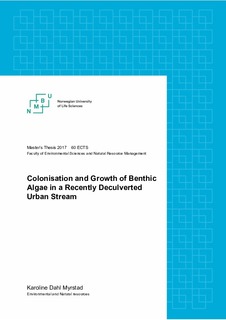| dc.description.abstract | Stream restoration by the process of deculverting is a comprehensive form of restoration which aims to improve morphological, chemical and ecological condition through the re-creation of a naturalized stream from a piped channel. Norway has adopted the process, and the municipalities are increasingly attempting to restore culverted streams wherever possible, particularly in the city of Oslo. It is, however, largely unknown how aquatic ecosystems will respond to the substantial changes associated with deculverting. This study examines the colonisation and growth of benthic algae assemblages a period after deculverting in a newly restored reach of the stream Hovinbekken in Oslo. Samples were collected monthly from May to November 2016 and in May and June the following year. Accumulation of benthic algae and concentration of nutrients were investigated to determine the stream’s ability to self-clean downstream the restored reach. Colonisation and composition of benthic algae taxa were investigated to determine whether the newly established ecosystem showed signs of being normal functioning. The ecological status of the restored reach was determined using benthic algae as indicators according to the periphyton index of trophic status (PIT). Additionally, this study assesses the performance of the BenthoTorch, an in-situ tool that provides estimations of algal biomass measured as Chlorophyll-a.
Results from the samplings showed no clear evidence of an overall decline in concentrations of nutrients along the restored reach. Neither was the differences in nutrient concentration along the restored reach significantly related to algal biomass measured as estimated percent cover. High levels of nutrients were conceivably a contributing factor for the massive growth of the cyanobacterium Oscillatoria sancta and the filamentous green algae Spirogyra majuscula which occurred during both seasons of sampling. Additionally, the estimated percent cover of benthic algae was generally high in the restored reach, which after a period of drought rapidly accumulated at the sites that had been affected by these disturbances. Furthermore, according to PIT, the classification for all sites in the restored reach ranged between moderate and very poor ecological status. And, there were no significant differences in PIT downstream along the restored reach. Thus, the results of this study imply that nutrient was not a limiting factor for algal growth in the restored reach and that levels of nutrients were too high for algae to noticeable control the nutrient dynamics in the stream. Conceivable, without reducing levels of nutrients contaminating the water from upstream sources, it is likely that the benthic algae growing in the restored reach would only be limited by substrate space on which to colonize.
Results from the samplings showed that the algal community in the restored reach had a significantly larger richness of benthic algal taxa in 2017 compared to the previous season 2016. An interesting observation was also that new taxa were establishing in the restored reach in 2017. And, a temporal pattern of seasonal succession in the benthic algae community occurred during both seasons, a seasonal shift which happened earlier in 2017 than in 2016. Thus, these findings indicate that the dynamics of the benthic algal ecosystem were showing signs of functioning normally. Findings also suggest an ongoing colonisation process among benthic algal communities in the restored reach.
Results from assessing the BenthoTorch showed that μg chlorophyll-a/cm2 measured by the BenthoTorch was significantly related to benthic algal volume estimated as percent cover. However, there was a large degree of deviation from the regression line. Thus, results of this study demonstrate that the BenthoTorch should be used with extreme care as there is a risk that the BenthoTorch will greatly under or overestimate benthic algal biomass. | nb_NO |

